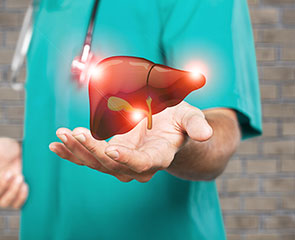
Non-alcoholic fatty liver disease (NAFLD) is one of the most common complications of diabetes. It often remains undiagnosed until the manifestation of end-stage liver damage, making it imperative for people with diabetes to monitor their liver health.
Dr M Shafi Kuchay, consultant endocrinologist, Medanta- The Medicity Hospital, Gurugram, says, “NAFLD happens due to lack of physical activity and improper diet. Usually, when we consume excess calories, the fat gets deposited under the skin, leading to obesity. But excess fat gets deposited on organs like liver. Over time, this fat accumulation on the liver can affect health as it creates more insulin resistance.”
READ MORE :
Nine natural supplements for a healthy liver
Beware of these liver health complications
Decoding the basic liver function tests
Diabetes and NAFLD
NAFLD is seen more in people with Type 2 diabetes because experts say that the pathophysiology of both the conditions are similar. Dr Abhijit Bhograj, consultant – Diabetes and Endocrinology, Manipal Hospital, Bengaluru, says, “In type 2 diabetes, there are other metabolic changes that happen, and the liver is central for most of the process. If the diabetes is left uncontrolled, it can lead to insulin resistance and then changes in cholesterol levels and increased inflammation. This triggers NAFLD.”
Dr Kuchay also says that on average, about 60 to 70 percent of people with diabetes end up developing NAFLD and Dr Bhograj adds that NAFLD is prevalent among 25 percent of global population.
Dr Bhograj says growing incidences of NAFLD in people with Type 1 diabetes are being observed now. “They are insulin deficient, and it can affect the liver too. These are, however, early findings that we are starting to see,” he says.
How serious is NAFLD?
Dr K. S. Soma Sekhar Rao, consultant gastroenterologist, hepatologist & therapeutic endoscopist, Apollo Hospitals, Hyderabad, says, “If we see more than 5% of fat accumulated on the liver, we call it fatty liver, but liver damage is caused when it grows to 30%.”
He adds that normally, the fat gets accumulated between the Glisson’s capsule, which can cause some nagging pain on the right side of your upper abdomen. He says, “Fatty liver may present with other associated symptoms like dizziness due to high BP and polyuria due to diabetes. That is when NAFLD is mostly identified.”
And if it is left untreated, it can lead to Non-Alcoholic Steatohepatitis (NASH), which can cause permanent damage to the liver. NASH is inflammation of the liver due to excess fat accumulation. “It leads to liver cirrhosis. But these manifestations are not presented for about 10 to 15 years.” It can further progress to hepatocellular carcinoma (liver cancer).
Dr Rao recommends a person with diabetes to undergo a baseline liver function test (LFT), ultrasound of the abdomen and FibroScan, which quantify the amount of fat deposit. He says, “Based on your findings, if the fat content is very high and LFT is showing elevated levels of Serum Glutamic Oxaloacetic Transaminase (SGOT) and Serum Glutamic Pyruvate Transaminase (SGPT) enzymes, then you need to repeat the tests once in three to six months. If the LFT is normal and FibroScan is not showing much fat, you need to repeat the test at least once a year.”
A review article published in January, 2022, has shown an association between type 2 diabetes and liver disease even with little to no alcohol consumption.
Management of fatty liver disease
The key to prevent or reverse NAFLD is to keep blood glucose level under control. “Secondly, lifestyle related measures like weight optimisation and physical activities can help. Losing 10% of the body weight will reduce the progression of NAFLD,” says Dr Bhograj.
Experts say that there are no medications to treat the condition, but some medications used for diabetes management can help reduce weight, which in turn can help reduce fat deposit on the liver.
Dr Kuchay cites an example of a person with diabetes who consulted him in 2019. “A 39-year-old professional managed to reverse his fatty liver disease which was diagnosed incidentally during his diabetes check-up. His condition had progressed to mild fibrosis but with proper diet and exercise, he managed to reverse his condition in eight months,” he recalls.
Takeaways:
- Uncontrolled diabetes and obesity can cause permanent damage to the liver.
- NAFLD is caused by fat accumulation on the liver, even if you consume little to no alcohol. It does not present any symptoms and often remains undiagnosed until a liver function test is done.
- If left untreated, it can progress to NASH, which can cause permanent damage to the organ.
- It leads to cirrhosis and puts one at higher risk of developing liver cancer.


















2 Responses
Very informative….
Thanks for the positive response!